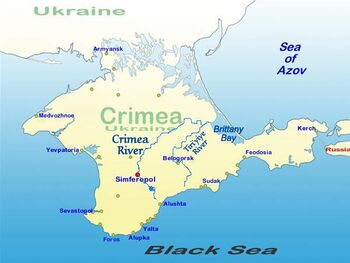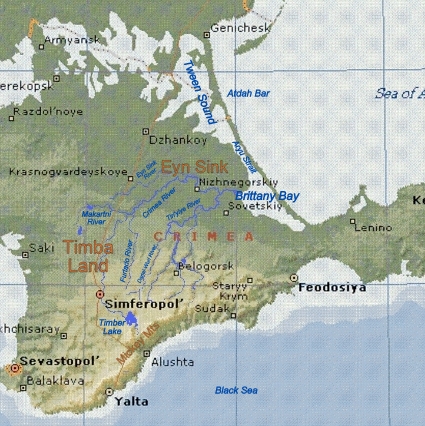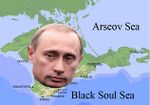Crimea River

“Crimea — Together we'll crack it!”
The Crimea River is a negligible, scenic river in Ukraine (or occasionally Russia) that commands a significant historical drainage basin. It flows 230 miles through the densely forested region of Timba Land before discharging its silt into Britanny Bay. Its source is the remote Timber Lake, a popular vacation spot for many Europans, which are not to be confused with Europeans. The surrounding area is notable for both the Yalta Conference and the town of Simferopol, the place where more tears are shed per capita than anywhere else in the world.
Geography[edit]
The Crimea River is located on the Crimean Penninsula, which dangles loosely off the bottom of Ukraine. At 230 miles long, it is the longest river on the peninsula, and also the most voluminous in terms of record sales.
Source[edit]

The Crimea River begins its journey to the sea high in the Mickey Mountains, near Aguilera Peak, often called X-Mountain due to the number of people who have died attempting to climb on top of it.[1] It then flows as a small creek into Timber Lake. Timber Lake is not the true source of the Crimea River; however, due to its slightly more accessible location and more tourist/vacation/tween-friendly climate, it is generally stated as the source.
Timba Land[edit]
After exiting the Mickey Mountains and Timba Lake, the Crimea River flows into the forested Timba Land, where the most vibrant parts of its history take place (see below). The Crimea River joins with the Furtado River before diving off the plateau and into Boiband Depression, a large lowland created by the fluffy and thin support of the ground beneath it, having an alluvial fan for its base. This creates many problems in the area, most noticeably the enormous Sophomore Slump, a slow-moving landslip that kills and injures hundreds each year due to a strange sonic resonance that can cause severe damage to the eardrum. In the Boiband Depression, it joins with the Makartni River near Dream Street in lovely downtown Chlymidia before flowing into the massive (much more massive than it should be) Eyn Sink.
Eyn Sink and lower reaches[edit]
When the Crimea River is in Eyn Sink, it stagnates and slows down considerably. It meanders across the lowlands, entering Bothseksez, an experimental rock bed. While in Eyn Sink, the river is said to be in its lower reaches. Just after trying Bothsekez, the Crimea River hits Rock Bottom, a nearly impermeable band of rock that saves curses the river and redirects it straight toward Brittany Bay. This is where the Crimea River reaches its lowest point and takes the easiest route (to sea, that is). When depositing its fluids into the bay, which isn't very hard to do, it also drops a lot of silt, grime, and bad karma. The waters from the river quickly get the heck out of Brittany Bay through the Aryu Strait, passing the rock formations known as the Brittany Spears and proceed to get lost and confused in the swampy muck of Tween Sound. Eventually, the waters finally find their way to the open ocean, usually ending up in a Black Sea, where they seem to think they belong.
History and Culture[edit]
The Crimea River and the sorrounding area has a long, rich, and varied history. The area is known as one of the saddest places on the planet, causing suffering and unhappiness to mankind since Jesus stubbed his toe in Simferopol in 22 A.D. Even earlier than that, the Black Sea dried up during the Messinian Salinity Crisis, leaving millions of fish flopping around comically on the ground. Then the sea refilled when the Bosphorus flooded, drowning all the fish that had now learned how to breathe air. Also, during the Crimean War, the flow of the Crimea River increased tremendously, causing some lady to do something about something else and whatever.
Breakup of the Band[edit]
During the days of the Soviet Union, the Crimea River pretty much sucked. There was hardly any water in it at all.
However, during the breakup of the former Soviet Union, the river meandered to spend more time with familiar surroundings and headed in a new direction. It was now able to flow where it chose to, without having to rely on other, less aesthetic rivers.
Super Bowl 38 Incident[edit]
The river was now independent, but it still was not a very famous river, and not many people noticed it. In order to garner attention, it flooded in 2004 into Bowl 38, a geographical basin where an annual football tournament is held. During a series of high notes, the river burst its banks and flooded the town of Janet, tearing off the dome covering the town's most sacred place. After seeing that the holy place was exposed, over 3,000 people committed suicide. Because the levee breach had occured at a drobe that had been in place since the Crimean War, the event was called either the War Drobe Malfunction or the Superbowl XXXVIII Halftime Incident because Bowl 38 is very large and because the flood happened at twice the speed as anticipated, giving viewers no time to avert their eyes.
Russian Invasion of 2014[edit]
Realizing that he left his favorite stuffed animal at his ex-girlfriend's house in Crimea 20 years ago, Vladimir Putin launched a massive invasion of the entire region in 2014.
Unfortunately, when his troops reached the banks of Crimea River, they were confronted by Justin Timberlake continuously singing which led to the Red Army being overcome by intense sadness and long looks back at their lives. U.S. President Barack Obama threatened Moscow with bare-bottom spanctions if they continued to endanger the Sexy stability of the region, which the U.S. had spent decades restoring after the Cold War. After 2 days, Putin called off the invasion, stating that "I don't know, I just wasn't feeling it ya know? I'm just really stressed out right now."
Happily, the Russian Army remained in position around each airport (to help passengers with their luggage) and in front of government buildings and broadcast studios. The people of the Crimea expressed their appreciation with a historic vote to return to Mother Russia.
Footnote[edit]
- ↑ It is actually a really easy climb.
